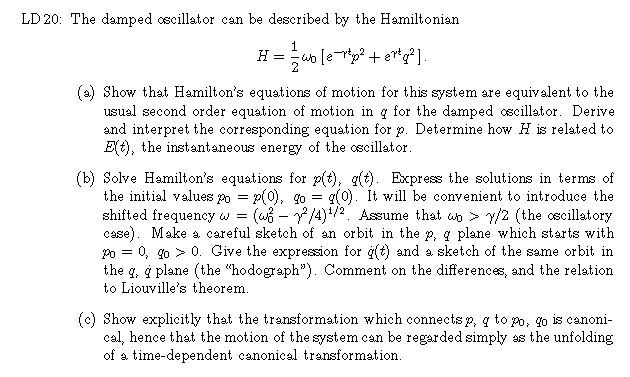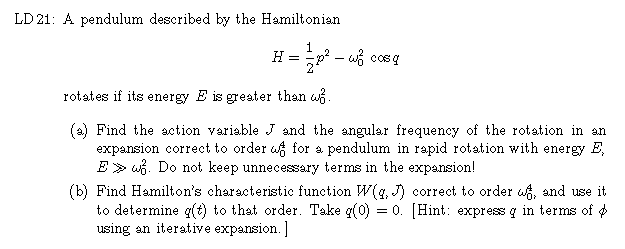
PROBLEM SET 11
Due Friday, April 30, 1999
Reading: Goldstein, Chaps. 10, 11 You may also want to look at Arnol'd, Secs. 46-52, to see the same material in a modern mathematical form.
Problems: LD 20-23

| This is an example of a Hamiltonian that depends explicitly on the time. Note that p is the canonical momentum of the damped oscillator, not its velocity. This difference is crucial in Liouville's theorem. |

Take the hints seriously! In (a), expand the expression for J in inverse
powers of E before integrating, and continue expanding as appropriate.
You will need to invert the expression approximately to find E(J)
which you can then use to find  . In (b)
you will need to use W(q,J) to get an expression for . In (b)
you will need to use W(q,J) to get an expression for
 as a function of q and J. Rewrite it as
q = as a function of q and J. Rewrite it as
q =  + ..., substitute
repeatedly for q in terms of + ..., substitute
repeatedly for q in terms of  the terms in the
ellipsis, and expand in the small parameter to obtain the iterative solution
for q. the terms in the
ellipsis, and expand in the small parameter to obtain the iterative solution
for q.
|

There is a subtlety in this problem: the solution for the initial
condition q(0) = 0 can (and will) involve  as well as
as well as  . This is possible because the
general Fourier
series includes a constant term a0 that can be used to
cancel the unwanted contribution from the cosine at t = 0. . This is possible because the
general Fourier
series includes a constant term a0 that can be used to
cancel the unwanted contribution from the cosine at t = 0.
The actual
calculation is straightforward, but can be messy if you do not think ahead
about the potential sizes of the various terms in the Fourier series.
A useful approach is to assume that all coefficients in the general
Fourier series are smaller than the coefficient of the leading term
that satisfies the initial condition, namely q = b1 |

Carry the calculation through to the point at which you have
explicit integral expressions for the time and angle as functions of r.
Find the turning points in the radial motion, determine the limit on
 that is necessary
for a real solution to exist, and specify your range of integration.
You do not need to
evaluate the final integrals. They can be evaluated in closed form,
but the results are not especially illuminating. However, you may wish
to show that the E = 0 orbits close by calculating the change in that is necessary
for a real solution to exist, and specify your range of integration.
You do not need to
evaluate the final integrals. They can be evaluated in closed form,
but the results are not especially illuminating. However, you may wish
to show that the E = 0 orbits close by calculating the change in  over one radial oscillation. over one radial oscillation. The potential in this example gives a very good approximation to the Fermi-Dirac statistical potential for electrons in an atom. The last electron in the neutral atom has a binding energy that is very small on the scale of the average atomic energies, and is taken as zero in the statistical model. Thus, you are calculating a reasonable approximation to the classical orbit of the last electron in a large atom. The angular momentum of this electron is limited as you found. The potential also has the interesting property of belonging to a class of "focussing potentials" with optical analogs. See Demkov and Ostrovskii, Soviet Phys. (JETP) 33, 1083 (1971). |
Send comments or questions to: ldurand@theory2.physics.wisc.edu
© 1997, 1998, 1999 Loyal Durand